
The ZX Spectrum is an 8-bit home computer developed and marketed by Sinclair Research. Considered one of the most influential computers ever made, it is also one of the best-selling British computers ever, with over five million units sold. It was released in the United Kingdom on 23 April 1982, and around the world in the following years, most notably in Europe, the United States, and Eastern Bloc countries.

Sabre Wulf is an action-adventure game released by British video game developer Ultimate Play the Game for the ZX Spectrum home computer in 1984. The player navigates the pith-helmeted Sabreman through a 2D jungle maze while collecting amulet pieces to bypass the guardian at its exit. The player does not receive explicit guidance on how to play and is left to decipher the game's objectives through trial and error. Sabreman moves between the maze's 256 connected screens by touching the border where one screen ends and another begins. Each screen is filled with colourful flora, enemies that spawn at random, and occasional collectibles.

3D Monster Maze is a survival horror computer game developed from an idea by J.K. Greye and programmed by Malcolm Evans and released in 1981 for the Sinclair ZX81 platform with the 16 KB memory expansion. The game was initially released by J. K. Greye Software in December 1981 and re-released in 1982 by Evans' own startup, New Generation Software. Rendered using low-resolution character block "graphics", it was one of the first 3D games for a home computer, and one of the first games incorporating typical elements of the genre that would later be termed survival horror.
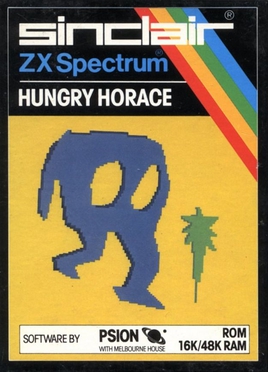
Hungry Horace is a video game developed by Psion Software Ltd. and published by Sinclair Research in 1982 for Commodore 64, Dragon 32/64, Timex Sinclair 2068, ZX Spectrum, and later for Microsoft Windows and Android. It is the first game in the Horace series. The gameplay is noted to be very similar to Pac-Man, involving the collection of food pellets in a maze while avoiding enemies. Despite this, critical reception of the game was generally positive upon release.
J.K. Greye Software was a British software company set up by J.K. Greye in early 1981 and 6 months later joined by Malcolm Evans after they met at a Bath Classical Guitar & Lute Society meeting in Bath in 1981. They produced computer games for the Sinclair ZX81 and ZX Spectrum home computers.
The ZX Spectrum's software library was very diverse. While the majority of the software produced for the system was video games, others included programming language implementations, Sinclair BASIC extensions, databases, word processors, spread sheets, drawing and painting tools, and 3D modelling tools.

Android Two is a shoot 'em up maze video game written by Costa Panayi and published by Vortex Software in 1983 for the ZX Spectrum and in 1985 for the Amstrad CPC. It is the sequel to Android One: The Reactor Run, released earlier in 1983.
Don Priestley is a teacher and former video game programmer who wrote over 20 commercial games for the ZX81 and ZX Spectrum home computers between 1982 and 1989. Despite successful releases for DK'Tronics, such as 3D Tanx and Maziacs, Priestley returned to teaching in the late 1980s, claiming changes in the video game industry did not suit his style of work.

Halls of the Things is a video game developed by Design Design for the ZX Spectrum and released by Crystal Computing in 1983. It was ported to the Amstrad CPC and Commodore 64. The player travels through seven floors of a tower, searching for seven rings, with each floor being a complex maze of corridors and rooms. Once the player has the rings they must then find the magical key hidden in the dungeon, which opens the drawbridge allowing the player to escape. To hinder the player's progress they are attacked by "things," but the player is armed with a sword, arrows, fireballs and lightning to aid you in the quest.

3D Tunnel is a shoot 'em up video game written by Malcolm Evans for the ZX Spectrum It was published by New Generation Software in 1983.
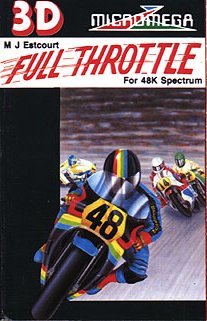
Full Throttle is a video game released in 1984 for the ZX Spectrum and written by Mervyn Estcourt, creator of Deathchase. The player races a 500cc Grand Prix motorcycle on any of ten of the world's top racing circuits. It was later ported to other platforms and released under the name Speed King.
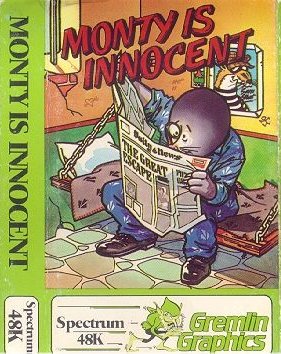
Monty Is Innocent is a video game written by Chris Kerry for the ZX Spectrum and published by Gremlin Graphics in 1985. It is a sequel to Wanted: Monty Mole released the previous year. While the game was marketed as Monty Is Innocent, it is never referred to by that title in-game; instead it merely displays Great Escape!. The inlay also features this title, on the newspaper that Monty Mole is reading in his cell.
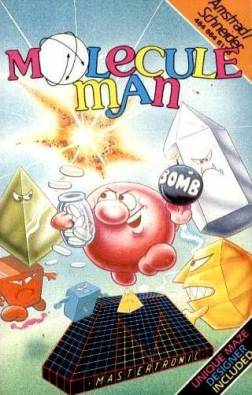
Molecule Man is an isometric 3D action-adventure video game released by Mastertronic in 1986 for 8-bit home computers. A level editor is included which enables the player to create their own mazes.

The Warlock of Firetop Mountain is an action game published by Crystal Computing in 1984 for the ZX Spectrum home computer. It is loosely based on the adventure gamebook of the same name written by Steve Jackson and Ian Livingstone, and published by Puffin Books in 1982.
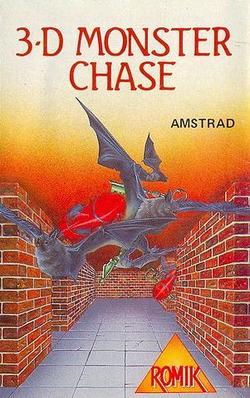
3-D Monster Chase is a first-person maze game written by Dave Noonan and released by Romik in 1984 for the Amstrad CPC and ZX Spectrum. A version for Camputers Lynx titled 3-D Monster Craze was developed by Camsoft.
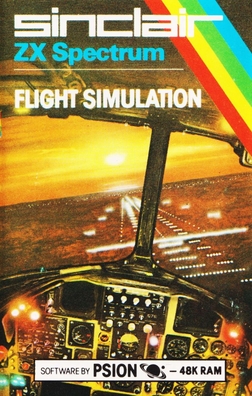
Flight Simulation is a flight simulation program written by Psion and marketed by Sinclair Research for the ZX Spectrum and ZX81 home computers.
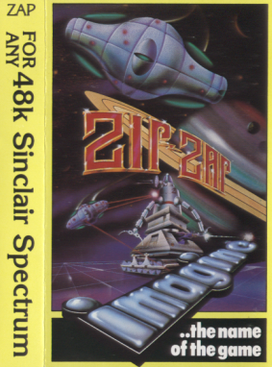
Zip Zap is an action game developed by Ian Weatherburn for Imagine Software and released for the ZX Spectrum in 1983.

Mined-Out is a maze video game created by Ian Andrew originally for the ZX Spectrum home computer in 1983. The objective is to carefully navigate a series of grid-shaped minefields by moving from the bottom to the top of the screen. The number of invisible mines in spaces adjacent to the player's current position is shown but not their precise location, requiring deduction to advance past them and avoid getting blown up. Additional challenges are introduced in later stages.
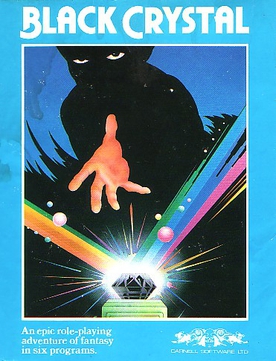
Black Crystal is an action-adventure game released in 1982 for the ZX81, ZX Spectrum, Commodore 64 and TI-99/4A computers by Carnell Software Ltd. It was the first in the "Third Continent Trilogy" of adventure games; followed by Volcanic Dungeon and The Wrath of Magra.

















